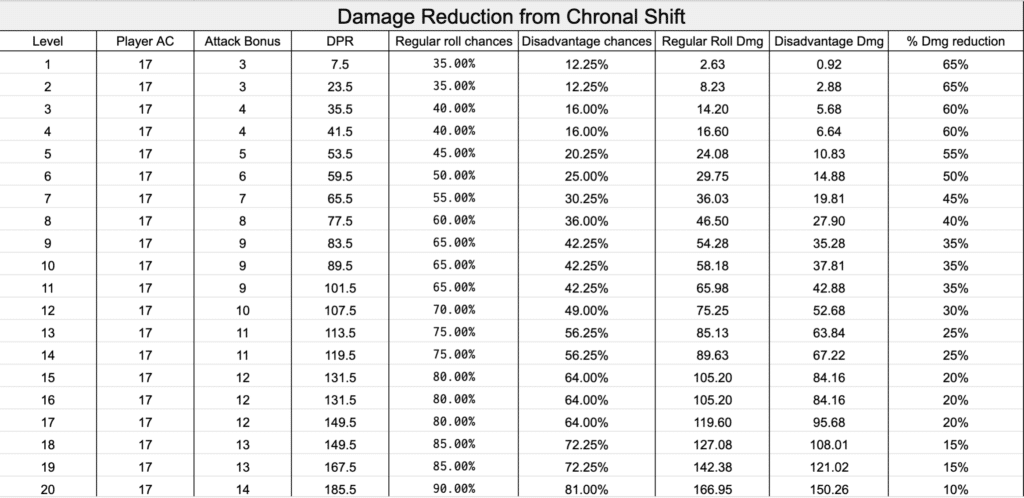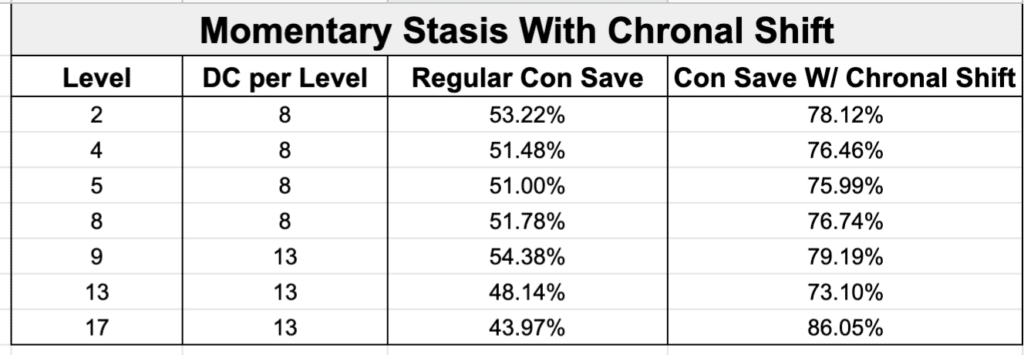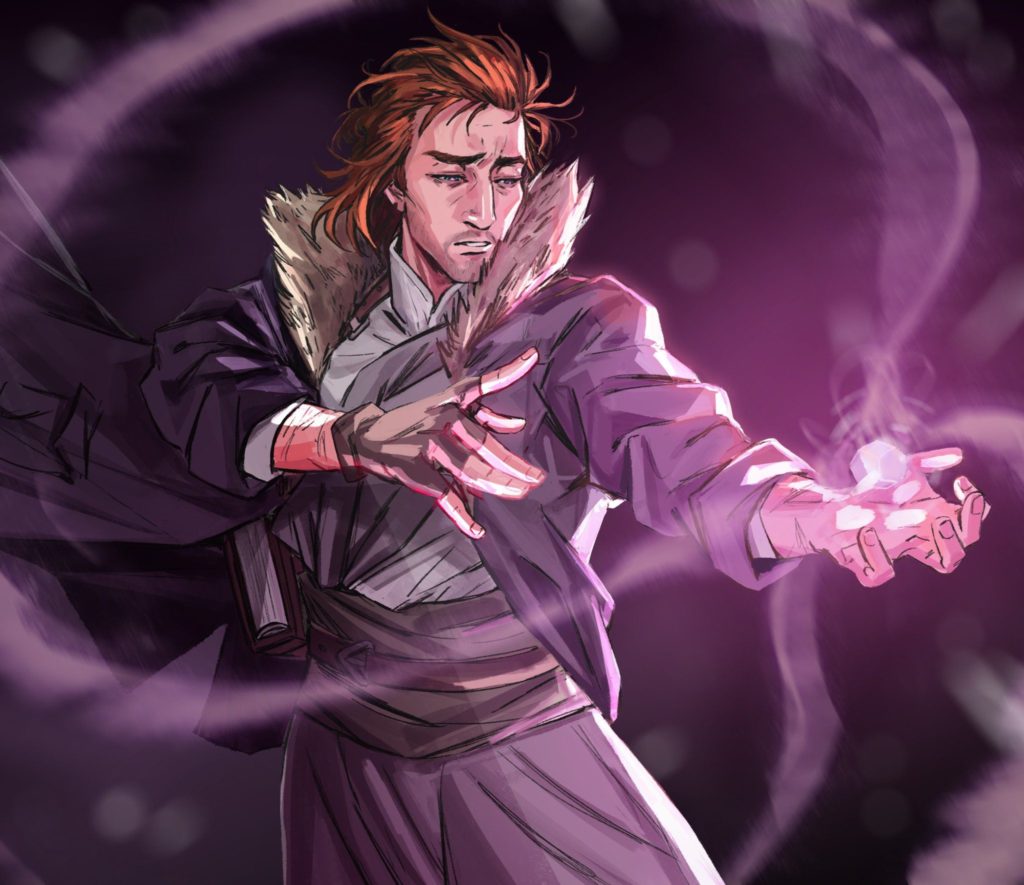The 5e Chronurgy Wizard.
If you have read my articles before, then you know the divination wizard is given the highest-ranking out of any subclass.
But, I give you the only subclass that has ever made me doubt my decision.
The abilities of the chronurgy wizard for 5e are insane.
Being both powerful, flexible, and unique makes this a great subclass no matter your playstyles.
How Am I Evaluating the Chronurgy Wizard
So, before we begin the review, we should go over what I am rating and how I get my decision.
There are three things that I look over in my review.
I first look at how strong the subclass is in combat, utility, and, if applicable, roleplay ability.
This way everyone’s playstyle can be shown to fit their needs.
Now, when deciding if something is good, I look at what the subclass is trying to accomplish.
Then at how successful it succeeds in that task.
For instance, in a previous article on the Bladesinger, I concluded it attempts to make you a competitive front line.
I then figure out how well that ability succeeds in letting you front line, as well as how soon it comes online.
If it is accomplished at level 2 then it is early game.
Level 6 is Early-Mid.
Accomplished at Level 10 is Late-Mid,
And Level 14 is late game.
I rate earlier tiers better as most D&D Campaigns do not go beyond level 8.
Without further a due, let start this review on the chronurgy wizard for 5e.
Color Coding: Meaning
If you are curious on what the colors mean click here to see the list.
Chronurgy Wizard 5e (Early Game)
I would give chronurgy magic a gold rating if I could.
The truth is, the chronurgy wizard for 5e is the best wizard subclass out there.
But, because it comes from a book that is not in the evergreen section for D&D 5e.
I cannot give it an official gold rating since it is not allowed in any evergreen campaign.
That said, the chronurgy wizard not only does it achieve its goal as early as level 2 but each of the following abilities plays off of each other in a way that makes it a powerhouse at every level.
So, let’s go over why each of these abilities is so powerful.
Dunamancy Spells For Chronurgy Wizard
Chronurgy Magic lets you choose from an expanded list of spells when you learn a wizard spell. The following spells are added to the wizard spell list for you.
Wizard level 1
You sap the vitality of one creature you can see in range. The target must succeed on a Constitution saving throw or take 1d4 necrotic damage and fall prone.
Read the full review here
You touch a willing creature. For the duration, the target can add 1d8 to its initiative rolls.
Read the full review here
Wizard level 3
Impart latent luck to yourself or one willing creature you can see within range. When the chosen creature makes an attack roll, an ability check, or a saving throw before the spell ends, it can dismiss this spell on itself to roll an additional d20 and choose which of the d20s to use. Alternatively, when an attack roll is made against the chosen creature, it can dismiss this spell on itself to roll a d20 and choose which of the d20s to use, the one it rolled or the one the attacker rolled.
If the original d20 roll has advantage or disadvantage, the creature rolls the additional d20 after advantage or disadvantage has been applied to the original roll.
Read the full review here
You flick your wrist, causing one object in your hand to vanish. The object, which only you can be holding and can weigh no more than 5 pounds, is transported to an extra-dimensional space, where it remains for the duration.
Until the spell ends, you can use your action to summon the object to your free hand, and you can use your action to return the object to the extra-dimensional space. An object still in the pocket plane when the spell ends appears in your space, at your feet.
Read the the full review here
Wizard level 5
You create intense pressure, unleash it in a 30-foot cone, and decide whether the pressure pulls or pushes creatures and objects. Each creature in that cone must make a Constitution saving throw. A creature takes 6d6 force damage on a failed save, or half as much damage on a successful one, and every creature that fails the save is either pulled 15 feet toward you or pushed 15 feet away from you, depending on the choice you made for the spell.
In addition, unsecured objects that are completely within the cone are likewise pulled or pushed 15 feet.
The full review can be found here
Wizard level 9
Target the triggering creature, which must succeed on a Wisdom saving throw or vanish, being thrown to another point in time and causing the attack to miss or the spell to be wasted. At the start of its next turn, the target reappears where it was or in the closest unoccupied space. The target doesn’t remember you casting the spell or being affected by it.
Wanna know if better than counterspell? Read the review here
Wizard level 13
Two creatures you can see within range must make a Constitution saving throw, with disadvantage if they are within 30 feet of each other. Either creature can willingly fail the save. If either save succeeds, the spell has no effect. If both saves fail, the creatures are magically linked for the duration, regardless of the distance between them. When damage is dealt to one of them, the same damage is dealt to the other one. If hit points are restored to one of them, the same number of hit points are restored to the other one. If either of the tethered creatures is reduced to 0 hit points, the spell ends on both. If the spell ends on one creature, it ends on both.
Read the full review here
Wizard level 15
You shatter the barriers between realities and timelines, thrusting a creature into turmoil and madness. The target must succeed on a Wisdom saving throw, or it can’t take reactions until the spell ends. The affected target must also roll a d10 at the start of each of its turns; the number rolled determines what happens to the target, as shown on the Reality Break Effects table.
At the end of each of its turns, the affected target can repeat the Wisdom saving throw, ending the spell on itself on a success.
Just how good is it? Read the full review here
Wizard level 17
Target a creature you can see within range, putting its physical form through the devastation of rapid aging. The target must make a Constitution saving throw, taking 10d12 necrotic damage on a failed save, or half as much damage on a successful one. If the save fails, the target also ages to the point where it has only 30 days left before it dies of old age. In this aged state, the target has disadvantage on attack rolls, ability checks, and saving throws, and its walking speed is halved. Only the Wish spell or Greater Restoration cast with a 9th-level spell slot can end these effects and restore the target to its previous age.
Full review can be found here
The spells have been gone over in other articles but are incredibly powerful.
Most noteworthy are sapping sting, fortunes favor, and Time ravage.
These are some of the strongest spells in the game for the goals they are trying to do.
If you want to learn more just click one of the links and read my review on the spell!
Temporal Awareness
Starting at 2nd level, you can add your Intelligence modifier to your initiative rolls.
I have talked about before how good going first in combat as a wizard in my guide on war wizards.
And this is no different.
Going first allows you to: (1) shut down dangerous enemies before they act, (2) buff key party members, or (3) deal high damage to bunched-up enemies.
In short, going first usually guarantees the most success for your actions.
Chronal Shift
Starting at 2nd level, you can magically exert limited control over the flow of time around a creature. As a reaction, after you or a creature you can see within 30 feet of you makes an attack roll, an ability check, or a saving throw, you can force the creature to reroll. You make this decision after you see whether the roll succeeds or fails. The target must use the result of the second roll.
You can use this ability twice, and you regain any expended uses when you finish a long rest.
Next, we have the strongest ability the chronurgy wizard in 5e can have; chronal shift.
This gives any player the ability to have the lucky feat twice a day, AND the ability to use this on the party as well.
That, is huge.
This increases anyone’s chances to succeed an attack roll by 32%, a saving throw by 21%, and the average hard skill check by 22%.
Meaning a party member will be successful at least 20% more of the time on their rolls.
Moreover, if you use this on enemies, you will reduce the amount of damage you take from anywhere from 10%-65% depending on level and AC.
As shown in the chart below.

Coupled with the fact that it can be used after you know if the roll fails or passes ensures you do not waste these.
Unlike divination wizard’s ability; portent, which forces you to do it before the roll.
As a result, the debate over which is better, portent or chronal shift was a challenging decision.
But ultimately the guaranteed rate of portents rolls makes portent keep the gold rating for the wizard while chronal shift gets sky blue.
Momentary Stasis
Starting at 6th level, as an action, you can magically force a Large or smaller creature you can see within 60 feet of you to make a Constitution saving throw against your spell save DC. Unless the saving throw is a success, the creature is encased in a field of magical energy until the end of your next turn or until the creature takes any damage. While encased in this way, the creature is incapacitated and has a speed of 0.
You can use this feature a number of times equal to your Intelligence modifier (a minimum of once). You regain all expended uses when you finish a long rest.
If Chronal shift was not powerful enough, then momentary stasis takes the cake.
Being able to lock down an enemy for one turn can be crucial in a battle.
Especially toward flying creatures or creatures about to do some serious damage.
For example, if an Ancient dragon is flying when you use this ability and they fail, then they will fall to the ground.
As shown here by sage advice.
Now, let’s say you realized that the party messed up their grouping in a battle.
So, now an ancient red dragon has the perfect line of sight to deal 26d6 points of damage to the entire party.
Use Momentary stasis and shut them down until your party can readjust.
On average, you can expect a monster to fail the con save 43-53% of the time.
But with chronal shift, you can expect the monster to fail 78-82% of the time.
Netting a 25% boost to the abilities effectiveness for the 5e chronurgy wizard .

This is an incredibly powerful ability that synergizes with their level 2 abilities really well.
Making this a sky blue rating as well.
Arcane Abeyance
Beginning at 10th level, when you cast a spell using a spell slot of 4th level or lower, you can condense the spell’s magic into a mote. The spell is frozen in time at the moment of casting and held within a gray bead for 1 hour. This bead is a Tiny object with AC 15 and 1 hit point, and it is immune to poison and psychic damage. When the duration ends, or if the bead is destroyed, it vanishes in a flash of light, and the spell is lost.
A creature holding the bead can use its action to release the spell within, whereupon the bead disappears. The spell uses your spell attack bonus and save DC, and the spell treats the creature who released it as the caster for all other purposes.
Once you create a bead with this feature, you can’t do so again until you finish a short or long rest.
This is one of my favorite abilities the 5e chronurgy wizard has.
Its ability for versatility, power, and roleplay can be incredibly powerful.
Allowing you to create seemingly infinite combinations for a task at hand.
Need to concentrate on two spells?
Use arcane abeyance and let you and the fighter both concentrate on spells.
Or, what about giving greater invisibility to the parties rogue on a stealth mission?
Now they can decide when to use it in which part of the mission.
Thus, improving their odds of survival.
These are just two ways to use this ability and I could create more.
In fact, here are 10 more combo’s this spell allows you to use.
10 uses of arcane abeyance
- Haste+greater invisibility= high damage
- Give familiars to the WHOLE party
- Condense long casting time spells like glyph of warding into an action.
- Condense ritual spells you don’t have prepared into an action for when a foreseeable future arises
- Pop a Leomunds tiny hut in battle
- Trick an enemy or NPC into casting the spell on themselves or someone you want (polymorph/ Fireball/ & prestidigitation (soil) are a few good ones
- Giving enhanced ability to two people needing to pass a skill check.
- Any good spell who is going to be in a fight you aren’t in.
- Get around the bonus action and main action spell casting ruling (you are not casting the spell but using an item instead)
- Get around counterspells (same as above)
And these are just a few ways to use this, there tons of threads out there discussing how to break it.
My personal favorite is getting around the bonus action spell, and main action spell limitation as well as popping leomund’s tiny hut in battle.
Much for the same reason, I love rope trick in battle so much.
Still, while its ability is strong, it really relies on knowing the rules of the game which can be difficult for a lot of players and DM’s.
Making this a solid blue rating.
Convergent Future
Starting at 14th level, you can peer through possible futures and magically pull one of them into events around you, ensuring a particular outcome. When you or a creature you can see within 60 feet of you makes an attack roll, an ability check, or a saving throw, you can use your reaction to ignore the die roll and decide whether the number rolled is the minimum needed to succeed or one less than that number (your choice).
When you use this feature, you gain one level of exhaustion. Only by finishing a long rest can you remove a level of exhaustion gained in this way.
I like how Matt Mercer was like, “I don’t know if the chronurgy wizard was powerful enough, let’s make sure they are!”
It allows for me to gush over every single ability they have and convergent future is no different.
Convergent future is actually better than portent in my opinion.
The reason is, while portent can give you a 78-97% chance of success rate, convergent future gives you a 100%.
Moreover, portent only changes the dice roll, while convergent changes the number rolled.
This may not seem like much, but the big difference comes in the following example.
Say the storm giant needs to make a strength save of 15 against your spell to suffer some sort of negative effect.
Lucky for you, you have portent and even got a 1 for the day!
You use the 1 thinking they will fail.
In reality, the storm giant will still pass as they have a +14 to their save, thus giving them the 15 needed to pass.
Now, let’s say you are a chronurgy wizard and use convergent future on them.
This ignores the dice roll and automatically makes it the number below the needed amount.
Giving that storm giant a 14 even though they should not be able to roll that low.
The implications of this spell are huge.
This means a DC of 1 can be failed with convergent future as it changes the number to 0!
Now there are a few reasons why convergent future will not matter in a scenario.
A rogue’s reliable luck automatically gives them a 10 as the lowest their number can be.
Meaning a rogue can never have a number below that.
Moreover, legendary resistances automatically make it a pass.
So, excluding those few situations, you can almost always guarantee that someone will fail or pass a roll when used.

Suggestions for Chronurgy Wizard 5e
As for suggestions, there are usually 3 things I always give recommendations for.
They are Race, Feats, & Personality.
The reason why is it allows everyone’s playstyles to be seen in a subclass as well as are the central parts to defining a character.
Race
For races, a high elf, halfling, or changeling are all good choices for various reasons.
A high elf has great synergy with feats like elvish accuracy as well as gaining you a huge pool of lore for your character.
Making them ideal for a combat playstyle.
Halflings also synergize well with chronurgust wizards in 5e due to their lucky ability and halfling feats.
Ideal for a utility playstyle.
While changelings, will give you a +1 to intelligence and give you a large pool of utility to work off of with their shapechanging abilities.
Making them ideal for a roleplay playstyle.
Each are better in certain playstyles but all can be played no matter your playstyle
Feats
Some great feats are obviously the lucky feat as it grants you 3 more uses of your level 2 ability each day.
Bountiful luck for support playstyles using a halfling race.
With Elvish accuracy being a great choice for combat focused playstyles that use elven backgrounds.
As you can see, a lot of these feats revolve around dice rolling as that is what your subclass does best!
Personality
For personality, it is pretty easy to go the “master of time”, “psychic” persona.
But I really like the idea of playing someone similar to The Doctor from Dr. Who.
They try to help others and their ability to understand time and other sciences really allows them to succeed where others fail.
Throw in a tragic backstory or a fun loving one and you are set to go on adventures with your companions.
Though, that idea could be a preference since I enjoy Dr. Who.
Chronurgy Wizard 5e Conclusion
In conclusion, the 5e chronurgist wizard is the most powerful subclass out there for wizards yet.
While not from a book with an evergreen selection, its ability to manipulate time, shut down enemies, and warp games to the party’s favor is something that should truly be noted.
Moreover, thanks to the general applications in this build, most players will enjoy this subclass no matter the playstyle.
That said, this class does lean a little more to the combat playstyle in comparison to the divination wizard.
Which leans toward an exploration playstyle.
If you are unsure what I am talking about, then I highly suggest checking out my beginners guide book!
Not only does it give you great tips and tricks to help players build fun characters, but it also goes over playstyles and how to effectively use them in any game.
Hope you have an absolutely splendiferous day, and look forward to seeing you here again.

